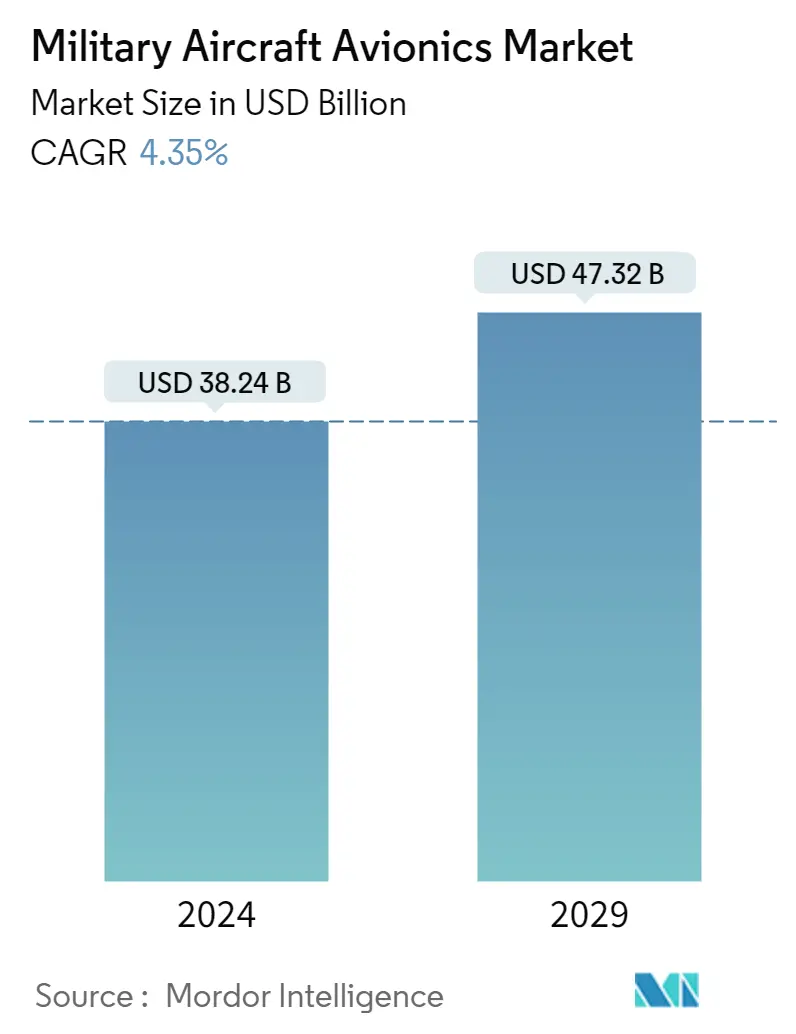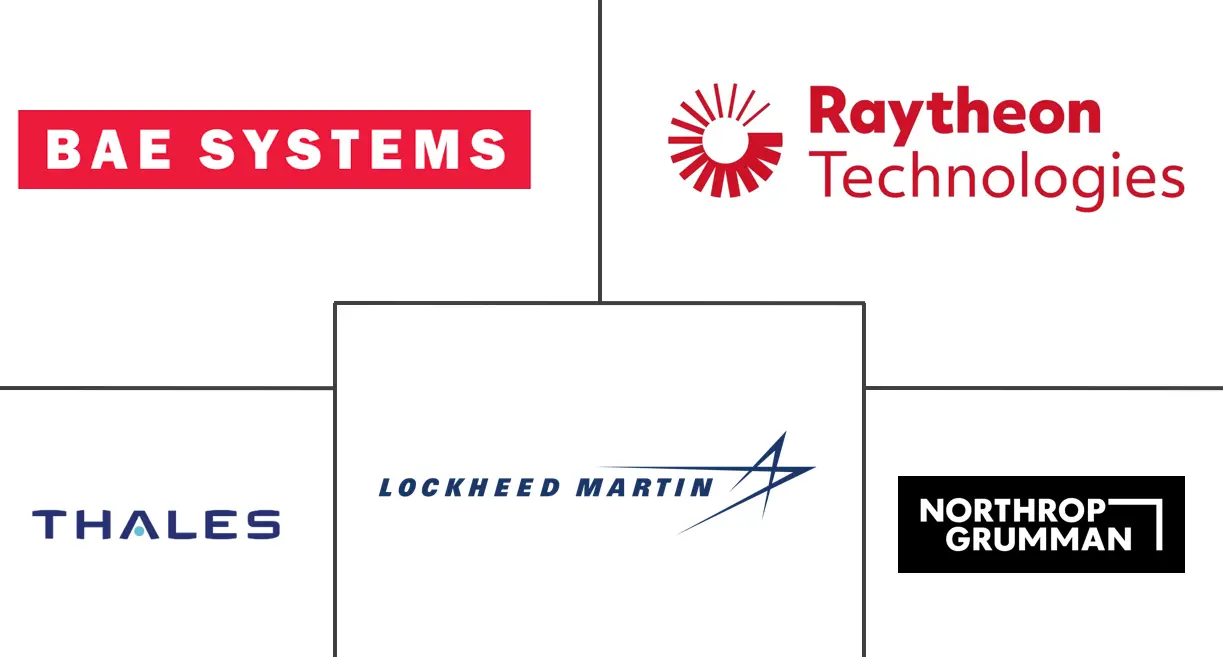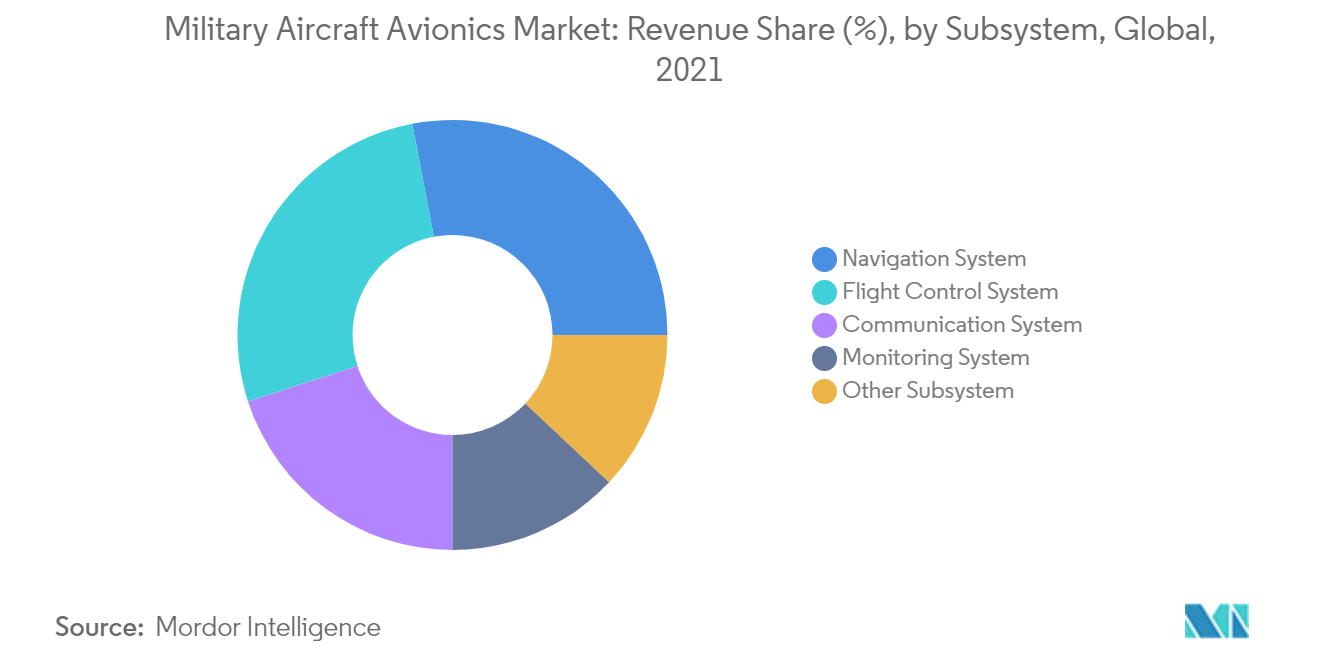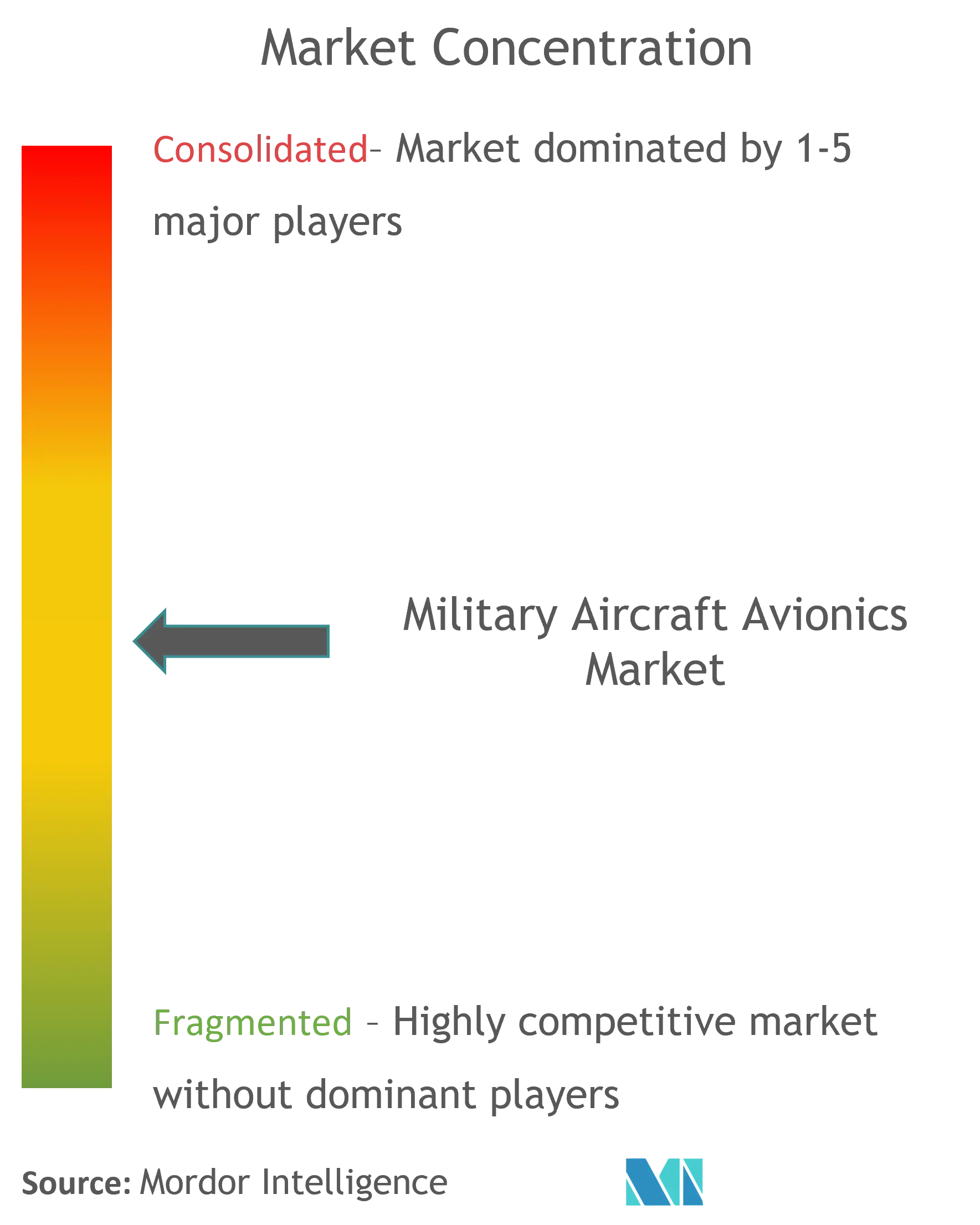Military Aircraft Avionics Market Size

| Study Period | 2019 - 2029 |
| Market Size (2024) | USD 38.24 Billion |
| Market Size (2029) | USD 47.32 Billion |
| CAGR (2024 - 2029) | 4.35 % |
| Fastest Growing Market | Asia Pacific |
| Largest Market | North America |
Major Players
*Disclaimer: Major Players sorted in no particular order |
Need a report that reflects how COVID-19 has impacted this market and its growth?
Military Aircraft Avionics Market Analysis
The Military Aircraft Avionics Market size is estimated at USD 38.24 billion in 2024, and is expected to reach USD 47.32 billion by 2029, growing at a CAGR of 4.35% during the forecast period (2024-2029).
In 2020, military aircraft deliveries decreased significantly due to the impact of the COVID-19 pandemic on the supply chain of certain aircraft programs. Nevertheless, the situation improved in 2021 for several military aircraft manufacturers worldwide. On the other hand, no visible impact was noted on the orders placed by various armed forces worldwide.
With the growth in defense spending by several nations across the globe, the industry has witnessed procurement and development activities for military aircraft in the last few years. This factor is currently driving the growth of the associated avionics market.
The development of new and advanced avionics is generating the need to replace old avionics systems in older military aircraft. These new avionics suites support the aircraft to meet the newer generation battlefield requirements like long-distance target detection and tracking, stealth, and electronic warfare defense. Therefore, to stay abreast of adversaries and allied military forces are devising modernization plans to upgrade the avionics suites in the military aircraft.
Furthermore, several countries are developing and procuring next-generation military aircraft to modernize and expand their fleets. This is also expected to drive the investments toward next-generation avionics and mission computers.
Military Aircraft Avionics Market Trends
This section covers the major market trends shaping the Military Aircraft Avionics Market according to our research experts:
Flight Control System is Expected to Register Highest Growth During Forecast Period
The military aircraft's flight control systems (FCS) include hardware and software systems for primary and secondary cockpit flight controls such as autopilot, data acquisition systems, flight recorders, aircraft management computers, active inceptor systems, and Electrohydrostatic Actuation (EHA) systems, among others. All military aircraft flight control systems are currently developed based on the Fly-by-Wire (FBW) technology. The aircraft OEMs are partnering with the avionics manufacturers to develop and integrate advanced flight control systems onboard the new-generation aircraft, which are planned to be inducted into service in the coming years. Also, companies are currently focusing on integrating advanced technologies like artificial intelligence (AI) and big data into computers to enhance the autonomous operations of human-crewed and uncrewed aircraft. For instance, in June 2019, Airbus Defense and Space partnered with Ansys to develop a new flight-control solution with sophisticated artificial intelligence (AI) for the Future Combat Air System (FCAS). The OEM plans to introduce autonomous flight capabilities onboard the aircraft by 2030. Such partnerships further enhance aircraft capabilities and are expected to accelerate the market's growth in the coming years.

North America Accounts for Major Market Share in 2021
North America is dominating the military aircraft avionics market in terms of revenue in 2021, owing to the large-scale procurement of military aircraft by the United States. The United States is the largest military spender in the world, with USD 801 billion in military expenditure in 2021. The US Air Force has spent the past four years improving the fleet mission-capable rates, reaching its lowest point (below 70%) in 2018. However, the rate is still around 72% as of December 2021. This has raised concerns and pushed the government to fill the gaps through new aircraft procurement and upgrade mission-related systems in the existing fleet. The US Air Force operates one of the oldest aircraft fleets compared to Russia and China's adversaries. Fielding of new aircraft has slowed the increase in fleet age, but the US Air Force is not buying enough new aircraft to sustain its force structure at its current size. The average age of some fleets is high, at 45 years for bombers, 49 years for tankers, and 29 years for fighter/attack aircraft. Also, the US armed forces are upgrading its existing fleet with advanced avionics to support a wide range of missions. For instance, In February 2022, the USAF finally announced its plan to upgrade its 608 F-16 Block 40 and 50 in one of the largest modernization initiatives in history. The F-16 Fighter jets will get up to 22 modifications that will increase the aircraft's lethality and ensure that the fourth-generation fighter can confront current and future threats. The 22 modifications include an Active Electronically Scanned Array radar, new cockpit displays, a mission computer, and a new database. Such investments of the countries in North America to enhance their aerial capabilities are anticipated to propel the growth of the market.

Military Aircraft Avionics Industry Overview
Some prominent players in the military aircraft avionics market are Raytheon Technologies Corporation, Lockheed Martin Corporation, Thales Group, BAE Systems plc, and Northrop Grumman Corporation. The players above have long-term contracts with various aircraft OEMs to provide avionic systems to their major aircraft programs. For instance, Thales Group is a prominent head-up display (HUD) provider that supports rotary-wing aircraft programs such as AH-1Z Viper, NH90, T129, Tiger, UH-1Y Venom, and Rooivalk helicopters. Similarly, BAE Systems provides an electronic warfare suite, active inceptor systems, vehicle management computer, and electronic components for communication, identification, and navigation systems onboard F-35 Lightning II fighter aircraft. To further enhance their presence in the market, the companies and adopting innovation as a key strategy that will allow them to capture new contracts with aircraft OEMs. For instance, Honeywell demonstrated various alternative navigation technologies for military aircraft in GPS-denied locations in April 2021, including information like position, velocity, and heading of the aircraft. These technologies include Vision-Aided Navigation, Celestial-Aided Navigation, and Magnetic Anomaly-Aided Navigation. The prototypes of alternative navigation technologies are expected to be available in 2022, and initial deliveries are planned to begin in 2023. Such innovations are anticipated to help the companies increase their market share.
Military Aircraft Avionics Market Leaders
Thales Group
Lockheed Martin Corporation
BAE Systems plc
Raytheon Technologies Corporation
Northrop Grumman Corporation
*Disclaimer: Major Players sorted in no particular order

Military Aircraft Avionics Market News
- In April 2022, Collins Aerospace announced that the company's Perigon computer would be the first certified aviation solution integrated with the Intel Atom x6400E processor. The processor will allow the Perigon computer to cater to next-gen flight control and vehicle management requirements across a broad range of commercial and defense platforms.
- In March 2022, Northrop Grumman Corporation was awarded a USD 65 million contract by the United States Navy to execute the full-rate production of Link-16 for the United States Marine Corps AH-1Z and UH-1Y military aircraft. The contract involves the integration of data link hardware across the fleet.
Military Aircraft Avionics Market Report - Table of Contents
1. INTRODUCTION
1.1 Study Assumptions & Market Definition
1.2 Scope of the Study
2. RESEARCH METHODOLOGY
3. EXECUTIVE SUMMARY
4. MARKET DYNAMICS
4.1 Market Overview
4.2 Market Drivers
4.3 Market Restraints
4.4 Porter's Five Forces Analysis
4.4.1 Threat of New Entrants
4.4.2 Bargaining Power of Buyers/Consumers
4.4.3 Bargaining Power of Suppliers
4.4.4 Threat of Substitute Products and Services
4.4.5 Degree of Competition
5. MARKET SEGMENTATION
5.1 Subsystem
5.1.1 Flight Control System
5.1.2 Communication System
5.1.3 Navigation System
5.1.4 Monitoring System
5.1.5 Other Subsystems
5.2 Aircraft Type
5.2.1 Fixed-wing Combat Aircraft
5.2.2 Fixed-wing Non-Combat Aircraft
5.2.3 Helicopters
5.2.4 Unmanned Aerial Vehicles (UAVs)
5.3 Geography
5.3.1 North America
5.3.1.1 United States
5.3.1.2 Canada
5.3.2 Europe
5.3.2.1 Germany
5.3.2.2 United Kingdom
5.3.2.3 France
5.3.2.4 Rest of Europe
5.3.3 Asia-Pacific
5.3.3.1 China
5.3.3.2 India
5.3.3.3 Japan
5.3.3.4 Rest of Asia-Pacific
5.3.4 Latin America
5.3.4.1 Brazil
5.3.4.2 Mexico
5.3.4.3 Rest of Latin America
5.3.5 Middle-East and Africa
5.3.5.1 Saudi Arabia
5.3.5.2 United Arab Emirates
5.3.5.3 Israel
5.3.5.4 Rest of Middle-East and Africa
6. COMPETITIVE LANDSCAPE
6.1 Vendor Market Share
6.2 Company Profiles
6.2.1 L3 Harris Technologies, Inc.
6.2.2 Raytheon Technologies Corporation
6.2.3 Lockheed Martin Corporation
6.2.4 Northrop Grumman Corporation
6.2.5 Thales Group
6.2.6 BAE Systems Plc.
6.2.7 Honeywell Internatonal, Inc.
6.2.8 Elbit Systems Ltd
6.2.9 Genesys Aero systems
6.2.10 Cobham PLC
6.2.11 Garmin Ltd.
6.2.12 Moog Inc.
7. MARKET OPPORTUNITIES AND FUTURE TRENDS
Military Aircraft Avionics Industry Segmentation
Military aircraft avionic systems include multiple electronic systems fitted on-board military aircraft to perform various functions. The market is segmented into subsystems the flight control system, communication system, navigation system, monitoring system, and other subsystems. The other subsystem segment includes health monitoring/management systems, terrain awareness and warning systems, and weather systems. Based on the aircraft type, the market is segmented into Fixed-wing Combat Aircraft, Fixed-wing Non-Combat Aircraft, Helicopters, and Unmanned Aerial Vehicles (UAVs). The report also covers the market sizes and forecasts in major countries across different regions. The report offers the market size and forecast in value (USD million) for all the above segments.
| Subsystem | |
| Flight Control System | |
| Communication System | |
| Navigation System | |
| Monitoring System | |
| Other Subsystems |
| Aircraft Type | |
| Fixed-wing Combat Aircraft | |
| Fixed-wing Non-Combat Aircraft | |
| Helicopters | |
| Unmanned Aerial Vehicles (UAVs) |
| Geography | ||||||
| ||||||
| ||||||
| ||||||
| ||||||
|
Military Aircraft Avionics Market Research FAQs
How big is the Military Aircraft Avionics Market?
The Military Aircraft Avionics Market size is expected to reach USD 38.24 billion in 2024 and grow at a CAGR of 4.35% to reach USD 47.32 billion by 2029.
What is the current Military Aircraft Avionics Market size?
In 2024, the Military Aircraft Avionics Market size is expected to reach USD 38.24 billion.
Who are the key players in Military Aircraft Avionics Market?
Thales Group, Lockheed Martin Corporation, BAE Systems plc, Raytheon Technologies Corporation and Northrop Grumman Corporation are the major companies operating in the Military Aircraft Avionics Market.
Which is the fastest growing region in Military Aircraft Avionics Market?
Asia Pacific is estimated to grow at the highest CAGR over the forecast period (2024-2029).
Which region has the biggest share in Military Aircraft Avionics Market?
In 2024, the North America accounts for the largest market share in Military Aircraft Avionics Market.
What years does this Military Aircraft Avionics Market cover, and what was the market size in 2023?
In 2023, the Military Aircraft Avionics Market size was estimated at USD 36.65 billion. The report covers the Military Aircraft Avionics Market historical market size for years: 2019, 2020, 2021, 2022 and 2023. The report also forecasts the Military Aircraft Avionics Market size for years: 2024, 2025, 2026, 2027, 2028 and 2029.
Military Aircraft Avionics Industry Report
Statistics for the 2024 Military Aircraft Avionics market share, size and revenue growth rate, created by Mordor Intelligence™ Industry Reports. Military Aircraft Avionics analysis includes a market forecast outlook to 2029 and historical overview. Get a sample of this industry analysis as a free report PDF download.
